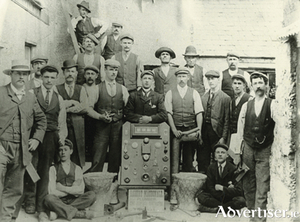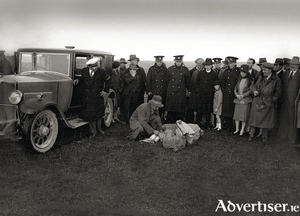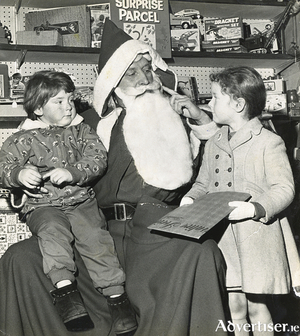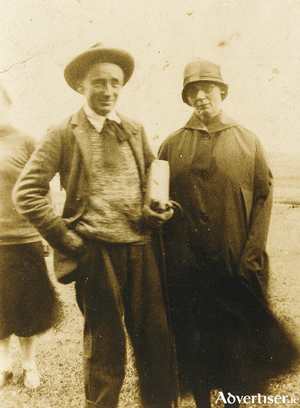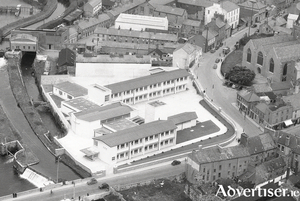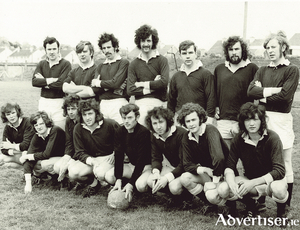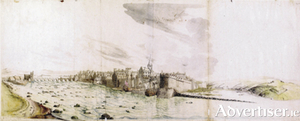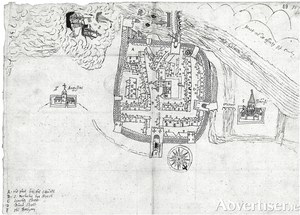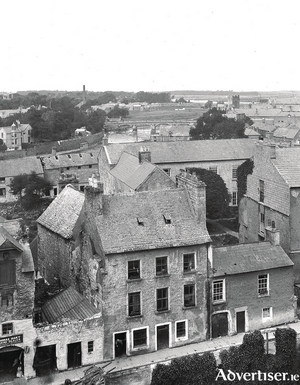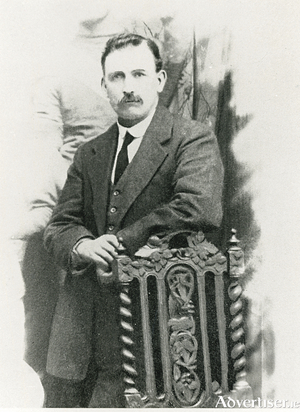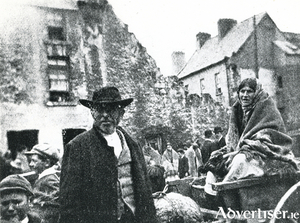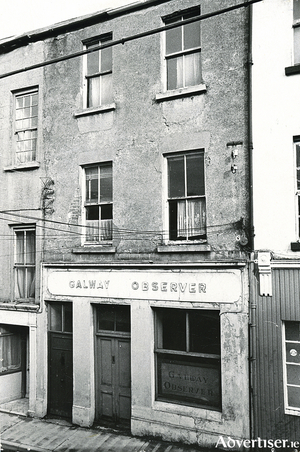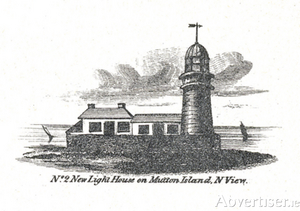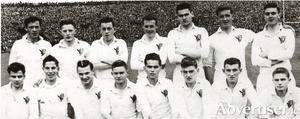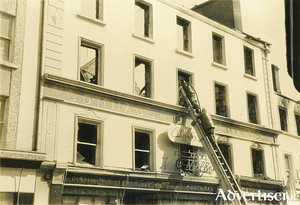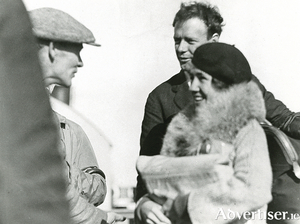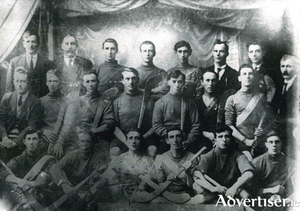Robert MacDonald, sanitary and heating engineer
Thu, Jan 05, 2017
This photograph was taken in 1900 of the staff of Robert MacDonald, the plumber from Dominick Street. The business was started by his father, Peter MacDonald (late manager for Ross and Murray), who advertised himself in 1887 as “Plumber, Brassfounder and Gasfitter”.
Read more ...The first Galway-London airmail flight
Thu, Dec 29, 2016
On August 26 1929, a North German Lloyd Liner arrived at 6.30am in the morning in Galway Bay from New York. Special bags of mail were immediately taken from the ship into Galway by launch, and together with mails that were especially made up in Galway Post Office, were rushed by car to Oranmore Airport. Notices has been placed in the Eglinton Street office saying that letters would have a special impress affixed for this flight, and that they should be posted early.
Read more ...The magic of Glynn’s
Thu, Dec 15, 2016
It was Leonard Martin’s idea to bring Santa Claus to Galway for the first time when he introduced him to his shop in Mainguard Street. It was such a novelty that the mayor, Joe Costelloe, came formally to the shop to welcome Santa and shake his hand. Leonard Martin’s shop (where St Anthony’s Credit Union is today) opened in 1941. For most of the year it was largely a hardware shop but at Christmas it became a toyshop exclusively. The man who played Santa Claus was a war veteran named Jack Kerr.
Read more ...Pádraic Ó Conaire and the Rising
Thu, Dec 08, 2016
Pádraic Ó Conaire was born on February 28 1882 in a pub by the docks, to middle-class Catholic publicans. He briefly attended the Presentation National School, but when his parents both died young he went to live with some of his extended family in Rosmuc. He later went to school in Rockwell and from there to Blackrock College in Dublin. He emigrated to London and took a lowly job in the civil service. He joined the local branch of Conradh na Gaeilge and flourished as an Irish language teacher and writer. In 1901 he published his first short story, An t-Iascaire agus an File.
Read more ...Persse’s Distillery, Nuns Island
Thu, Dec 01, 2016
In 1840, the Joyce family offered their distillery at Galway for sale. It was described as follows: “That large and valuable distillery establishment at Nun’s Island, at presently occupied and worked by Messrs. James and Patrick Joyce. Within the walls that surround the distillery there is a mill to which there is a store capable of containing several thousand barrels of grain and two kilns, Queen’s warehouse spirit and barm store with various other offices and conveniences. The distillery contains a wash still of 5,000 gallons; a Low Wine still of 3,000 gallons; 3 brewing coppers fit to contain about 200 barrels each, 7 fermenting backs of 14,000 gallons each; One mash Kieve with machinery capable of mashing 200 barrels of grain, and a mill capable of grinding over that quantity daily.
Read more ...St Patrick’s NS, a bird’s eye view, 1959
Thu, Nov 24, 2016
This photograph was published on March 13 1959 by Alexander ‘Monkey’ Morgan (1919-1958), a wartime pilot for the Royal Artillery Air Corps, who launched a peacetime career in aerial photography before his tragic death in a plane crash. It is a detail from one of the images he took for the Irish Independent between 1951 and 1958. Some 200 of these have now been published in book form under the title Ireland from the Air. The book is a crystal ball into the past. The images are of such high quality that the detail just leaps out. Our image today is just a section of one of the photographs which we have enlarged.
Read more ...Mary Anne Kelehan’s of Bushypark
Thu, Nov 17, 2016
The first time we see a pub in Bushypark recorded is in the 1902 Census which tells us that it was occupied by Mary Kelehan, a 45-year-old widow who is described as a publican. Also living there were her son Peter aged 26, as well as daughters Delia, 20, and Cissie, 18. All were described as publicans. There may well have been a pub there before that. It was a focal point for a large number of the local community and was the only place on the road where people could pull in for refreshments. On a Friday or Saturday evening it was common to see a line of horses and carts outside as people stopped on their way home after selling their turf or their produce at the market. The road was jammed early every Saturday morning with country folk driving their horses and carts to market.
Read more ...St Michael’s GAA Club, sixty years
Thu, Nov 10, 2016
St Michael’s Club was formed in 1956 after Galway won the All-Ireland football final. The first AGM was held in Tom Connolly’s house in Lower Shantalla Road, and they played their first game in 1957. Among those who founded the club were Pa Boyle (whose brainchild it was), Mick O’Toole, John Duignan, Mick Higgins, Liam Cunningham, and Sergeant O’Toole. They started as a dual club, but after a few years they concentrated solely on football.
Read more ...A prospect of Galway, 1685
Thu, Nov 03, 2016
This hand coloured prospect of Galway, looking northeast, was drawn in 1685 by Captain Thomas Phillips, surveyor-general of the fortifications in Ireland. It is especially important as it is the only quasi-objective pictorial record of Galway to survive from this period.
Read more ...Galway, historic towns atlas
Thu, Oct 27, 2016
On Monday next, November 1st, President Michael D. Higgins will launch the latest title in a series of Historic Towns Atlases of Ireland. This one is on Galway and is compiled by Jacinta Prunty and Paul Walsh. It is essentially an illustrated history of the development of the built up area of the city as seen through 57 illustrations starting with the earliest printed maps of Galway, antiquarian prints, 19th century paintings and photographs. Many of these are in colour, and many are A3 in size.
Read more ...Market Street, 1880, a bird’s eye view
Thu, Oct 20, 2016
This photograph is part of the Clonbrock Collection in the National Library, and was taken from the tower of St Nicholas’ Church in 1880, looking over Market Street. This panoramic view extends as far as the river. The chimney you see on the horizon was that of Persse’s Distillery. In the distance (you probably will not be able to see it in this reproduction) is the Clifden railway embankment running along the river bank. The building that is now the County Club is near the top left of the picture, the tower of the Mercy Convent near the top right.
Read more ...Mícheál Walsh, patriot
Thu, Oct 13, 2016
Mícheál Walsh was a native of Headford who bought the Old Malt pub and grocery in High Street c1906. He was a Republican and a member of the Urban Council. He once proposed at a meeting that the idea of toll booths, of collecting tolls from people bringing goods into the city, should be extended to include the docks in order that they might levy any ships coming in to the docks, including Navy vessels. This was too much for his fellow (Unionist) councillor Joe Young, who protested, “Sure if that was the way, no British naval vessel would ever come in to the docks.” “I rest my case,” said Mr Walsh.
Read more ...The Saturday market
Thu, Oct 06, 2016
The following observations of a Galway Saturday 100 years ago were made in a book entitled The Charm of Ireland by Burton E Stevenson which was published in 1915.
Read more ...The Galway Observer
Thu, Sep 29, 2016
Fifty years ago this weekend, on October 1 1966 to be precise, the last issue of the Galway Observer newspaper was published. It was founded in 1881, published on a Thursday (which was a half day in Galway) and circulated extensively in the city and county. In 1905 it declared itself as the “official advertising medium for the following public bodies – The Galway County Council, The Galway Town Council, Galway Rural District Council and Board of Guardians, Loughrea Rural District Council and Board of Guardians, Gort Rural District Council and Board of Guardians, Clifden Rural District Council and Board of Guardians, Galway Harbour Board, etc, etc.
Read more ...Mutton Island, Inis Caorach
Thu, Sep 22, 2016
In the year 1132, the King of Munster besieged Dún Bun na Gaillimhe (the fortification at the mouth of Galway) on Mutton Island and and destroyed the castle. There is a reference in the year 1190 to Lismacuan, ‘The Fort on the Mouth of the Harbour’. In 1641 an order was made that the lands of Mutton Island were to be made use of as commonage for the inhabitants of Galway.
Read more ...Galway minor footballers, 1960
Thu, Sep 15, 2016
The All-Ireland Minor Gaelic Football Championship for under-18 boys was introduced in the late 1920s by the GAA, the first champions were Clare in 1929.
Read more ...Galway fires
Thu, Sep 08, 2016
The Connaught Buildings on Mainguard Street originally housed Connolly’s, one of the largest hardware and fancy goods shops in Galway. It had an impressive four storey facade on the front and five storeys on the Church Street side. In 1934 the ground floor was leased by four tenants. A fire started on the first floor, the flames spread rapidly, and smoke could be seen rolling from the building. Half clad figures fought their way bravely down the stairs which threatened to give away any minute. The damage was extensive and estimated at £1,000, but much of the sum was made up of the stock of the ground floor tenants which included a lock-up fruit and vegetable shop rented by Mr P Hennigan. A Mr McDonnell and his brother had a tailoring business on the first floor.
Read more ...Lindbergh
Thu, Sep 01, 2016
Out of the mists of the Monday afternoon of October 23 1933, there came to Galway a seaplane with a blue black fuselage, orange wings, and silver floats. She circled low over The Claddagh, swooped across the old Spanish Arch, and taking a wide sweep over Lough Corrib, swung around and landed near the lighthouse at 65 miles an hour with scarcely a ripple on the water. Claddagh boats put out in welcome, for it was Colonel Charles A Lindbergh who had flown alone from New York to Paris in May 1927, in 33.5 hours. He had come to Galway as a technical adviser of Pan-American Airways to see what facilities Galway Harbour had to offer as a seaplane base. The Claddagh boatmen towed his plane into New Docks where he was met by several local dignitaries.
Read more ...The Fishmarket, 1908
Thu, Aug 25, 2016
“The Younger Women with their cloaks draped around their heads looked piquant enough, their faces had not unfrequently the sweetest expression of passion, and their lips pouted charmingly. The old fisher-wives, on the other hand, who sat near the casks and smoked damp tobacco in short clay pipes, had something witchlike and menacing about them.” So wrote Julius Rodenberg in 1860. He obviously had a thing for beautiful young Galway women as he also wrote about them elsewhere. As for the older women, I would say they just glared at him because he did not buy any fish. Otherwise, what he wrote could be true of our 1908 photograph.
Read more ...Galway club hurling, 1884 to 1934
Thu, Aug 18, 2016
An intriguing report appeared in the Galway Express of March 21 1903 which stated: “At Prospect Hill on St Patrick’s Day, two hurling matches were played between the Gaelic League v Queen’s College, and Castlegar v Bohermore. The National Independence Band, The Forster Street Fife and Drum Band and the Industrial School Band, with several thousand people, attended. In the match between the Gaelic League and Queen’s College, the League won by 3 – 3 to 2 – 0. Castlegar beat Bohermore.”
Read more ...